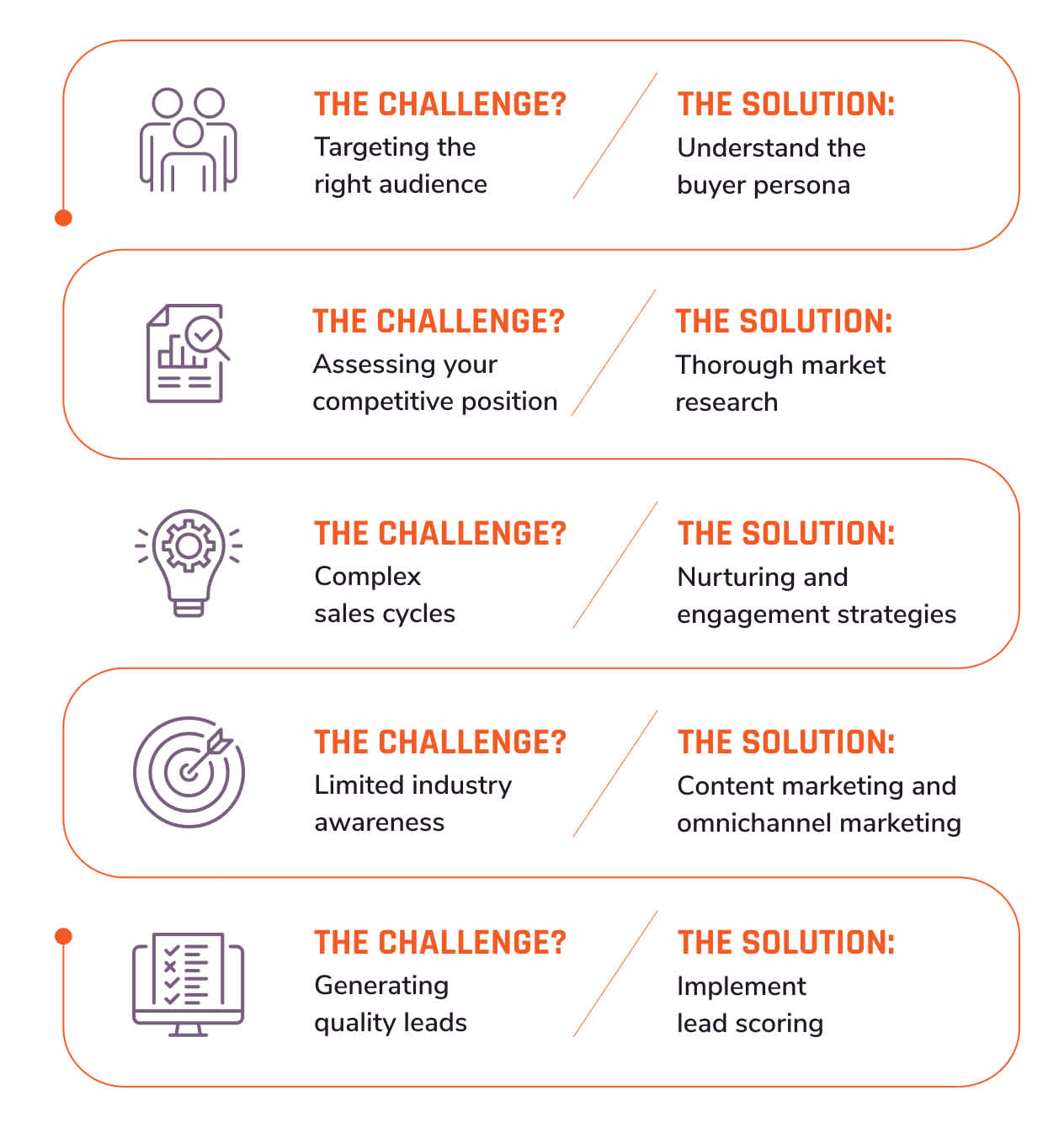//
Jul 12, 2023
Effective Strategies for Lead Generation in the Manufacturing Industry
The manufacturing industry faces unique challenges, demanding business owners change their approach to sales and generating high-quality leads.
In this blog post, we will delve into the world of , exploring actionable strategies and insights to supercharge your efforts.
Whether you're a marketing manager, sales executive, or business owner, this comprehensive guide will equip you with valuable information and practical tips to enhance your lead generation game. We understand, as a vital part of the economy, manufacturers are adept at overcoming various obstacles within their operations.
However, businesses that fail to adopt robust inbound lead-generation strategies specific to the manufacturing industry will likely fail at attracting as many potential customers and converting them into loyal buyers.
The Significance of Lead Generation for the Manufacturing Industry
When "marketing" comes to mind, you may associate it with e-commerce and retail consumer goods, such as magazine ads and commercials. If you work in the manufacturing industry as a manufacturer, supplier, or sales manager, you might believe that marketing is irrelevant to your industry, that you have referrals and returning business.
Unfortunately, there has been a prevalent mindset that marketing strategies take a backseat, with the belief if someone needs a product or service, they will seek it out, and if they don't, they won't.
However, in today's business landscape, personalization and connection are no longer an afterthought solely following the sale. They are now expected throughout the entire buyer journey, and this expectation extends to the manufacturing industry as well. And the emphasis on personalization and connection has become a vital aspect of the customer experience.
How is this achieved? Custom lead-generation strategies for the manufacturing industry.
Implementing a Data-Driven Lead Generation Strategy in the Manufacturing Industry

A well-strategized, data-driven lead generation approach brings numerous benefits to manufacturing businesses.
Here are some key benefits of adopting a custom data-driven approach:
- Enhanced Targeting and Segmentation
Data insights help companies segment their audience based on specific criteria like industry, job titles, and purchasing behavior, allowing manufacturers to customize their marketing messages to connect with the right audience.
- Improved Lead Quality
Manufacturers can use data analysis to find the best potential customers and concentrate on building relationships with them.
- Increased Efficiency and Cost-Effectiveness
Analyzing data on campaign performance to identify which channels, tactics, and messaging drive the most successful lead-generation outcomes.
- Personalized and Relevant Customer Experiences
Data-driven lead generation enables manufacturers to offer personalized and relevant experiences to potential customers.
- Continuous Optimization and Adaptation
By closely monitoring (KPIs) and metrics, manufacturers can identify areas for improvement and make data-backed decisions to refine their lead generation approach and continually optimize their strategies based on real-time insights.
Certainly, every market presents its own set of challenges. However, given the robust and agile nature of the manufacturing industry, you are well-equipped to tackle these challenges head-on.
Lead Generation Challenges and Solutions in the Manufacturing Industry

In the fast-paced manufacturing industry, lead generation can pose various challenges. By implementing effective strategies and solutions, manufacturers can overcome these hurdles and drive successful lead-generation campaigns.
First, let's explore some common challenges and practical solutions to help manufacturers optimize their efforts and achieve their business goals, then we’ll dive deeper into each solution.

Understanding the Right Audience: Inbound Marketing and Market Research
Defining the ideal is crucial in the manufacturing industry for effective lead generation. It helps tailor marketing and sales strategies to meet the target audience's specific needs.
Here's why it's important and key insights into the audience:
- Effective targeting: Focus on individuals or organizations most interested in your products/services, optimizing resources.
- Tailored messaging: Create personalized marketing messages addressing audience challenges, needs, and aspirations.
- Enhanced strategies: Understand preferred communication channels and behaviors to optimize marketing approaches.
Understanding Your Competitive Position and Buyer Behavior: Key Strategies for Manufacturers

In the manufacturing industry, it is crucial to have a clear understanding of where your company stands against your competitors as well as how your competitors are generating leads.
Here are some key strategies to help you address these challenges:
Competitor Analysis
To gain a competitive advantage, it is crucial to thoroughly study your competitors' products, pricing, marketing strategies, and customer feedback. By conducting a comprehensive analysis of these aspects, you can identify areas where your company can differentiate itself. By understanding your competitors' products, you can develop unique features or improvements that set your offerings apart in the market.
Pricing analysis helps determine competitive pricing strategies that attract customers while maximizing profitability. Studying marketing strategies enables you to identify gaps or new opportunities to reach and engage your target audience effectively.
Lastly, analyzing customer feedback provides valuable insights for enhancing your products and services based on customer preferences and addressing any pain points competitors may have missed. Ultimately, this knowledge empowers you to position your company as a distinctive and appealing choice for customers.
Hubspot offers to help you get started.
To establish yourself as an industry expert and provide valuable information to your target audience, iIt is essential to identify areas where your competitors have content that you currently lack.
By recognizing these gaps, you can strategically focus on filling them with high-quality and relevant information. Conduct thorough research and analysis of your competitors' content offerings, identifying topics, subjects, or perspectives that have been overlooked or insufficiently covered.
By addressing these gaps through well-researched articles, comprehensive guides, , or insightful podcasts, you can attract your target audience's attention and position yourself as a knowledgeable resource in your industry. This approach not only helps you differentiate from your competitors but also enhances your credibility and boosts your brand's reputation.
For inbound lead generation, it is essential to engage your audience and maximize conversion rates. A powerful strategy to achieve this is by conducting experiments with various versions of your marketing materials and web content. By testing different approaches, messaging, visuals, and calls to action, you can uncover what resonates most effectively with your target audience.
This iterative process allows you to gather valuable insights, refine your marketing strategies, and optimize engagement. Ultimately, implementing the findings from these experiments can lead to higher conversion rates, increased customer satisfaction, and improved overall success in reaching your marketing and sales objectives.
Web Content Audits:
Regularly reviewing your web content is crucial to maintain its relevance and effectiveness. By aligning your content with your buyer persona, you ensure that it speaks directly to your target audience's needs, interests, and pain points.
Furthermore, tailoring your content to address their pain points at each stage of the buyer journey enhances their experience and increases the likelihood of conversion. Consistently providing valuable, targeted information builds trust and credibility with your audience, establishing you as a reliable source and improving the overall user experience.
SEO Data Analysis:
Leveraging is crucial in gaining valuable insights into buyers' search behaviors, preferences, and pain points. By analyzing this data, businesses can uncover patterns, trends, and user intent, enabling them to refine their content strategy.
Armed with this knowledge, organizations can develop targeted content that directly addresses the needs and interests of their audience. By catering to these specific preferences and pain points, businesses can enhance user engagement, increase conversions, and establish themselves as authorities in their respective domains.
Furthermore, incorporating analytics data into content strategies can boost , as search engines prioritize relevant and user-focused content. Ultimately, using website analytics data to inform content creation yields a powerful strategy for maximizing online visibility and connecting with the target audience effectively.
Pssst…Are you up to speed on ?
Managing Complex Sales Cycles: Nurturing and Engagement Strategies

Manufacturing sales cycles can be lengthy and involve multiple stakeholders.
Manufacturers can overcome this challenge by implementing effective nurturing and engagement strategies like:
- Marketing automation: Streamline marketing tasks and workflows through , saving time and ensuring consistent engagement with leads.
- campaigns: Implement campaigns that nurture relationships with leads over time, providing them with relevant and valuable content tailored to their needs and concerns.
- Leveraging CRM software: Use to track interactions, capture customer data, and personalize communication.
- Track customer interactions: Monitor and analyze customer interactions across various touchpoints to gain insights and enhance engagement.
- Personalized communication: Deliver targeted messages and content to leads based on their behavior and preferences.
- Optimize the sales cycle: Utilize CRM data and insights to optimize the sales cycle, improving conversions and customer satisfaction.
Build Industry Awareness with Content and Omnichannel Marketing

To overcome limited industry awareness, manufacturers should prioritize building brand visibility and credibility.
By consistently delivering valuable content across multiple channels, manufacturers can increase industry awareness and establish themselves as thought leaders.
Here are two leading strategies to accomplish this:
Content marketing
encompasses various forms of content, such as informative blog posts, articles, case studies, and videos, all aimed at showcasing the knowledge and expertise of a business while offering solutions to specific challenges within the industry.
These content pieces serve as valuable resources for target audiences, providing them with relevant and insightful information that addresses their pain points and helps them make informed decisions.
By consistently creating and sharing high-quality content, businesses can establish themselves as thought leaders, gain trust from their audience, and ultimately drive customer engagement, brand awareness, and conversions.
Effective Strategies for Content Distribution Include:
- Guest Blogging: Collaborate with industry influencers and thought leaders to publish guest posts on their platforms.
- Industry Partnerships: Forge strategic partnerships with complementary businesses in the manufacturing ecosystem.
- Influencer Outreach: in the manufacturing industry and engage them to promote and share your content. Influencer endorsements can amplify your reach and lend credibility to your brand.
Omnichannel marketing:
Omnichannel marketing is a strategic approach that extends the reach of your content by utilizing a diverse range of sales and marketing channels. It goes beyond traditional methods by seamlessly integrating multiple platforms and touchpoints to create a unified and cohesive customer experience.
Here are a few ideas to get you started:
- Utilize social media platforms to share and promote your content, engage with industry-related discussions, and interact with potential leads.
- Participate in relevant industry forums to showcase your expertise and connect with other professionals.
- Host webinars and participate in industry events to further amplify the reach of your content and establish your brand presence.
- Attend networking and trade show events to connect with industry professionals.
By adopting these strategies, manufacturers can effectively overcome limited industry awareness, reach a wider audience, and establish themselves as industry leaders.
Maximizing Lead Quality: Implementing Lead Scoring for Effective Lead Generation

Lead scoring is a valuable approach that assigns numerical values to leads based on their engagement, demographics, and behavior.
By implementing lead scoring, manufacturers enjoy the following benefits:
- Prioritizing efforts: Focus on leads with higher conversion potential, allowing you to allocate your time and resources more efficiently.
- Optimal resource allocation: Allocate your marketing resources and budget effectively by directing them towards leads with higher scores and a greater likelihood of conversion.
- Improved efficiency: Streamline your lead management process by identifying and focusing on leads most likely to become customers, increasing efficiency and productivity.
- Higher quality leads: Attract and convert high-quality leads more likely to become loyal customers, resulting in long-term business growth and success.
Leading Your Leads: Utilizing Lead Magnets and Landing Pages for Successful Conversions

To ensure your leads stay aware of the journey, it's important to have a clear closing target. That's where lead magnets and landing pages come in. These powerful tools can help you capture manufacturing leads effectively and encourage lead conversions.
Here's how to make the most of them:
- Lead Magnets: Offer valuable resources or incentives to attract and engage potential customers. Tailor your lead magnets to your audience's needs and pain points.
- Persuasive Landing Pages: Design dedicated web pages that convert visitors into leads. Use clear messaging, compelling visuals, concise copy, and a strong CTA.
- Optimizing Lead Capture Forms and CTAs: Keep forms simple, position them prominently, and test variations to maximize conversions.
By leveraging lead magnets and well-designed landing pages, you can guide your leads towards the desired action and increase your chances of converting them into loyal customers.
Grow your manufacturing business with inbound marketing
Boost visibility, create engagement, increase leads and make more money with Inbound Marketing
Inbound marketing is a powerful strategy helping manufacturers reach their target audience, generate leads, and build relationships with customers. If you're not using inbound marketing, you're missing out on opportunities to grow your business.
Understanding the significance of effective lead-generation strategies is crucial to drive business growth. Targeting the right audience, navigating complex sales cycles, and leveraging digital marketing channels is essential to capture high-quality leads.
Incorporating lead scoring, understanding the buyer persona, staying ahead of competitors, and utilizing lead magnets and landing pages further enhance lead generation efforts. By implementing these proven strategies, you can maximize your marketing efforts, unlock new growth opportunities, and convert leads into loyal customers. Take advantage of the chance to take your manufacturing business to new heights with .
Take the Lead with Watermark’s Lead Generation Solutions
For expert assistance in lead generation and conversions, partner with Watermark, a digital marketing expert specializing in the .
today for a free consultation!







